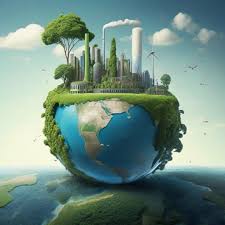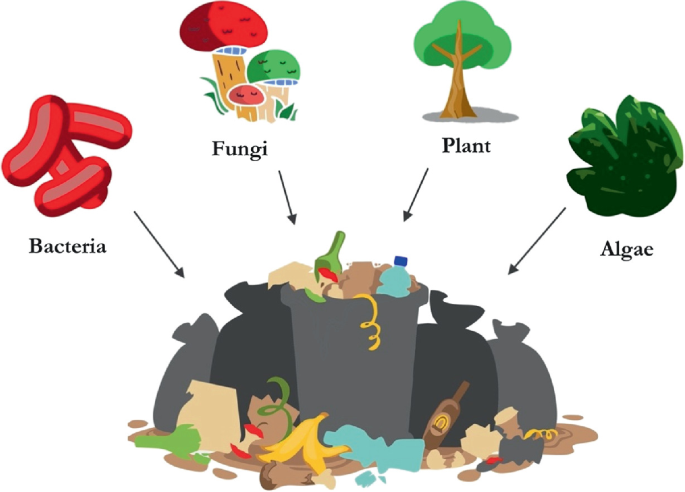Authors: Yahaya Sumara Sulley1, Lydia Quansah1,2 Shamsiyatu Murtala2 & Sena Abla Zonu2
Department of Forensic Sciences, Faculty of Biosciences, University for Development Studies, Tamale – Ghana
Department of Biotechnology, Faculty of Biosciences, University for Development Studies, Tamale – Ghana
Introduction
Climate change is one of the greatest threats facing humanity, with the potential to cause irreversible damage to the planet and its ecosystems. Biotechnology, on the other hand, offers new and innovative approaches to address the challenges posed by climate change. This write-up will provide an overview of climate change and the global conversation around it and further highlight solutions to achieve sustainable climate action.
Climate change refers to the long-term alteration of the planet’s climate patterns (1), resulting from increased atmospheric concentrations of greenhouse gases (2). These gases, such as carbon dioxide, methane, and nitrous oxide, trap heat in the atmosphere and cause global temperatures to rise. This temperature rise has a range of impacts, including sea level rise, changes in precipitation patterns, and increased frequency and severity of extreme weather events, such as hurricanes, floods, droughts, and wildfires.
SDG 13 and the Global Conversation on Climate Change
The sustainable development goals (SDGs) are a set of 17 global goals, adopted by the United Nations in 2015, to create a more sustainable future for all. The SDGs provide a framework for addressing a range of societal challenges, including poverty, inequality, and climate change (3).
Sustainable Development Goal 13, focuses on taking urgent action to combat climate change and its impacts primarily from human activities such as burning fossil fuels, deforestation, and industrial processes. It has significant and far-reaching impacts on the environment, economies, and societies, particularly on vulnerable populations.
Climate change has become a topic of global concern, with governments, organizations, and individuals taking action to address its impacts. The Paris Agreement, signed in 2015 by 196 countries, is a landmark agreement that aims to limit global warming to well below 2 degrees Celsius above pre-industrial levels. The agreement recognizes the critical role of technology, including biotechnology, in achieving this goal (4).
Global solutions toward climate change include a range of approaches, such as energy efficiency, renewable energy, carbon capture, and storage, and climate adaptation. Biotechnology solutions also have a crucial role to play in achieving sustainable climate action. For example, biotechnology can be used to develop alternative sources of fuel, such as biofuels, which emit fewer greenhouse gases than traditional fossil fuels.

Biotechnology Solutions for Sustainable Climate Action
Biotechnology refers to the use of living organisms or their derivatives to create products or processes that address a variety of societal challenges, including those related to climate change. Biotechnology has already revolutionized various fields, including medicine, agriculture, and energy, with the potential to transform the way we address climate change.
There are a number of ways biotechnology can contribute towards sustainable climate action. Biotechnology can be used to develop more sustainable agricultural practices, such as precision farming and genetic engineering, which can reduce the environmental impact of agriculture.
The following are potential biotechnology solutions that could contribute to sustainable climate action in the future;
Bioenergy: One of the most promising biotechnology solutions for sustainable climate action is bioenergy. Bioenergy refers to the use of biological materials, such as plants, algae, and waste, to generate energy. This approach has the potential to reduce greenhouse gas emissions by providing an alternative to fossil fuels. Bioenergy can also help to reduce waste and improve energy security. For example, the use of agricultural waste and forestry residues to generate bioenergy can reduce the amount of waste sent to landfills and provide energy for rural communities (5).
Bioplastics: Another promising biotechnology solution for sustainable climate action is bioplastics. Bioplastics are made from renewable resources, such as plant starches and cellulose, and are biodegradable or compostable. The use of bioplastics can reduce the reliance on fossil fuel-based plastics and reduce waste (6). Bioplastics can also help to reduce the carbon footprint of plastic production, as they require less energy and emit fewer greenhouse gases during production.
Bioremediation: Bioremediation is the use of living organisms or their products to clean up contaminated sites. This approach can be used to remove pollutants from soil, water, and air. Bioremediation can help to reduce the impact of pollution on the environment and human health (5). For example, the use of plants to remove pollutants from soil and water can reduce the need for costly and environmentally damaging remediation techniques.

Waste Management: Waste management is another critical sector that needs to transform to achieve sustainable climate action. Biotechnology solutions offer a range of approaches to make waste management more sustainable and efficient (6). For example, biotechnology can be used to develop more efficient and effective ways to convert waste into biofuels and other useful products.
Genetic engineering: Genetic engineering is a powerful tool that can be used to improve the sustainability of agriculture and food production. Genetic engineering can be used to develop crops that are more resistant to pests and diseases, require less water and fertilizer, and can grow in marginal or degraded lands (7). These traits can help to reduce the environmental impact of agriculture and improve food security (1). For example, the development of drought-resistant crops can help farmers in arid regions to grow crops with less water, reducing the impact of water scarcity on food production.
Microbial biotech solutions: Microbial solutions refer to the use of microorganisms to solve environmental problems. Microorganisms can be used to clean up contaminated sites, produce biofuels, and improve soil health (6,8). For example, the use of bacteria to produce biofuels can reduce the carbon footprint of transportation and provide an alternative to fossil fuels. Microbial solutions can also help to improve soil health, reducing the need for chemical fertilizers and improving crop yields.
Industrial biotech solutions: The industry is a major contributor to greenhouse gas emissions and a critical sector that needs to transform to achieve sustainable climate action. Biotechnology solutions offer a range of approaches to make industrial processes more sustainable and efficient. For example, biotechnology can be used to develop biodegradable plastics and enzymes that can break down pollutants. Biotechnology can also be used to develop more sustainable and efficient manufacturing processes, such as bio-based chemicals and materials with very minimal reliance on fossil fuels and greenhouse gases as sources of energy (5).
Carbon Capture and Storage: Carbon capture and storage is a critical technology that can enable the reduction of greenhouse gas emissions from industrial processes. Biotechnology solutions offer a range of approaches to enhance the efficiency and effectiveness of carbon capture and storage technologies. For example, biotechnology can be used to develop microorganisms that can absorb and store carbon dioxide (5).
The Goal is Sustainable Climate Action
In conclusion, climate change is a complex and urgent challenge that requires a range of innovative and sustainable climate action solutions. Biotechnology solutions offer a promising path toward achieving sustainable climate action, by providing new approaches to address the challenges posed by climate change.
To achieve SDG 13, it is crucial to reduce greenhouse gas emissions, increase renewable energy use, improve energy efficiency, and enhance resilience and adaptive capacity to climate-related hazards. This requires global cooperation, policy frameworks, and technological advancements to shift towards low-carbon and sustainable pathways. Failure to address climate change will have severe consequences for the planet and future generations, underscoring the urgency and importance of SDG 13.
Policymakers, industry leaders, and individuals should prioritize the development and adoption of biotechnology solutions, to enable a more sustainable and resilient future for all. By investing in biotechnology solutions for sustainable climate action, we can create a more equitable, prosperous, and sustainable world.
Acknowledgment
Special thanks are due to “The Biotechnology Research Interest Group 2022” of the University for Development Studies (UDS) Department of Biotechnology class of 2021 for their contribution towards the preparation of this article.
References
1. Munaweera TIK, Jayawardana NU, Rajaratnam R, Dissanayake N. Modern plant biotechnology as a strategy in addressing climate change and attaining food security. Agriculture & Food Security. 2022;11(26):1–28.
2. Kaddo JR. Climate Change : Causes , Effects , and Solutions. A with Honors Projects. 2016;164.
3. The 17 Goals | Sustainable Development [Internet]. [cited 2023 Apr 3]. Available from: https://sdgs.un.org/goals
4. The Paris Agreement | United Nations [Internet]. [cited 2023 Apr 3]. Available from: https://www.un.org/en/climatechange/paris-agreement
5. Ezeonu CS, Tagbo R, Anike EN, Oje OA, Onwurah INE. Biotechnological Tools for Environmental Sustainability : Prospects and Challenges for Environments in Nigeria — A Standard Review. Biotechnol Res Int. 2012;1–26.
6. Venkatesh A, Posen ID, MacLean HL, Chu PL, Griffin WM, Saville BA. Environmental Aspects of Biotechnology. Adv Biochem Eng Biotechnol [Internet]. 2020 [cited 2023 Apr 2];173:77–119. Available from: https://pubmed.ncbi.nlm.nih.gov/31396652/
7. Naz Z. Introduction to biotechnology. 2015.
8. Dua M, Singh A, Sethunathan N, Johri A. Biotechnology and bioremediation: successes and limitations. Appl Microbiol Biotechnol [Internet]. 2002 [cited 2023 Mar 14];59(2–3):143–52. Available from: https://pubmed.ncbi.nlm.nih.gov/12111139/
